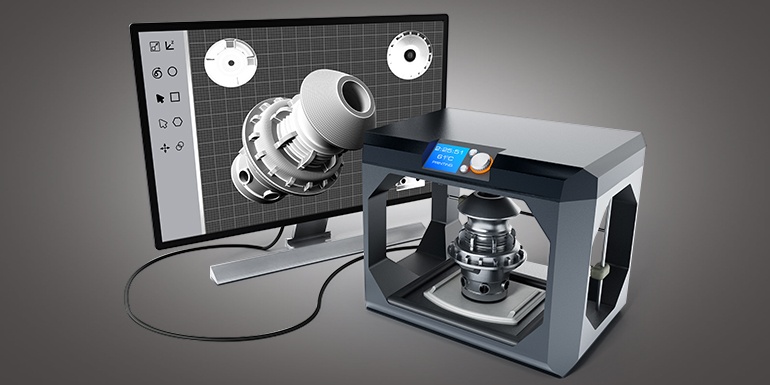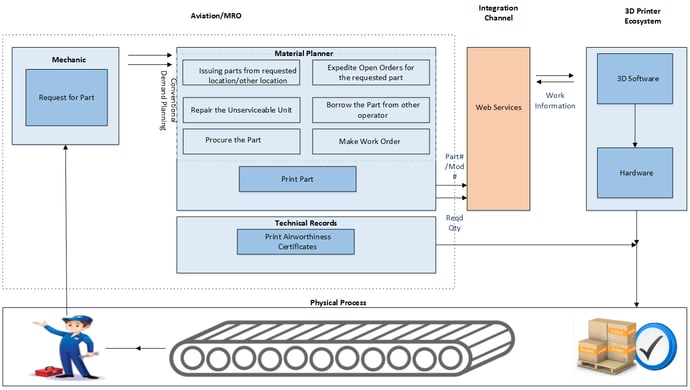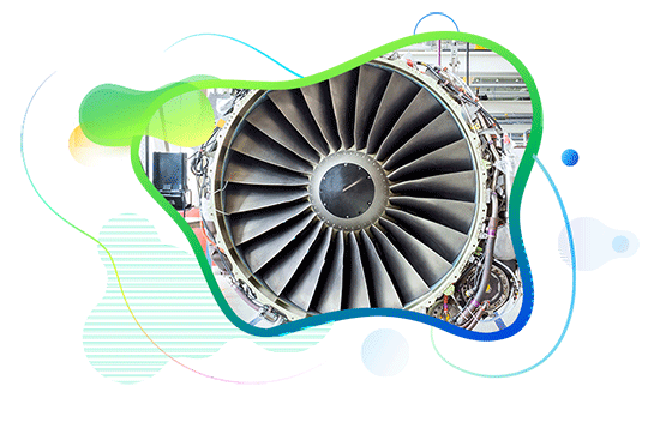

OEMs continue to make tremendous strides through adapting new technologies like 3D printing in the areas of manufacturing Parts in order to achieve lighter in weight high complex designs with reduced Lead Time, thus increasing the aircrafts’ efficiency.
3D printing is also known as Additive Manufacturing process and is usually referred to as Fused Deposition Modelling (FDM) or Fused Filament Fabrication (FFF). In simpler terms, this means that FDM printers extrude a small amount of heated material, which is typically a type of plastic, to build an object or objects layer by layer. While there is a small percentage of Stereo Lithography (SLA) printers that harden a pool of polymer liquid resin by exposing it to focused UV light, most 3D printers are of the FDM variety. 3D printing of the part is new technology introduced in the aviation industry for manufacturing aircraft parts.
A study published in ‘Gartner’ on May 6, 2015 by Brian Krassenstein states that Airbus have decided to implement Additive Manufacturing that replaces the conventional manufacturing process for parts which are made up of plastics. Latest edition of Airbus Family - A350 xwb comes with more than 1000 parts manufactured using 3D print[1] technology.
It is a great opportunity for Part 21 Certified Operators and MRO’s to adopt ‘3D - Printing’ to cope up with current best in practices set by manufacturers.
DIGITAL INVENTORY DEMAND PLANNING

SCENARIO
The Mechanic raises part request for getting the parts to perform maintenance activities in Line/Hangar/Shop.
Those part requests will be forwarded to the material planner to take necessary action and planner checks for the requested part in the stores associated to the Line/Hangar/Shop. If the part is available, Material Planner creates a pick list to issue the requested part. If the part is not available in the requested location, the material planner checks for the availability of parts in other location. If the part is available, he/she raises stock transport order to bring the part from the other location to the requested location.
Nevertheless, if the part is not available in the other location then the material planner checks the records to see whether any open order documents exists for the part which is not delivered. In case, if he/she finds any pending order documents, then the material planner expedites the supplier/shop/repair agency/carrier to receive the part ordered or in the transit. If there are no open orders, then the material planner checks the unserviceable store for the availability of the requested part. If it is available in stores then the part is send to the repair agency for repairing the part. If the part is not available, then the material planner decides to borrow the part from the pool or from other operators to meet the urgent demand. If requested part is not available, then he decides to procure the part or manufacture the part based on the capability of organization.
The aforementioned process is conventional demand planning method to satisfy the need raised from the production/shop floor. Conventional Demand Planning requires more lead time to process the part and storage space.
WHAT IF THERE IS AN ECOSYSTEM THAT MANAGES THE PLANNING IN AN EFFECTIVE MANNER?
When material planner identifies the requested part can only be printed in 3D-Print technology, he/she sends request to print the part in the 3D printer by activating print part function in ERP. This information is transferred to the 3D printer ‘Eco System’ through the integration channel. Integration channel integrates ERP and 3D printer environment through Web Services.
3D printer software matches the information sent from the ERP (Part #, Mod #...) to the design repository maintained. On matching, 3D printer starts printing the part. On completion, work information is sent back to the ERP for airworthiness certificate preparation and to track the actual work hours. Technical Records person records the technical parameters and Issues airworthiness certificate for the parts after inspection and the same will be sent to mechanic. Of course, the assumption here is the 3D Printer is fully geared up to fulfill such requests and eventually this will have to form part of the planning cycle.
An article on Additive Manufacturing in E&T[2], points out, additive manufacturing as one of the fastest-growing production markets and the global market is expected to increase from a 2013 revenue figure of $3.07bn to $12.8bn by 2018, and exceeding $21bn by 2020. Aerospace and defense production and aviation maintenance, repair and overhaul applications currently account for around 15 per cent of the additive manufacturing global market. This will be a game changer to an MRO Aviation Operators which can yield higher profits in near future with new technology in place.
[1] Refer http://www.gartner.com/smarterwithgartner/what-3d-printing-means-for-your-supply-chain/ posted on May 6, 2015 by Brian Krassenstein |
[2] Refer https://eandt.theiet.org/content/articles/2016/10/3d-printing-in-the-aviation-industry/ posted on October 11,2016 by Jade Fell


